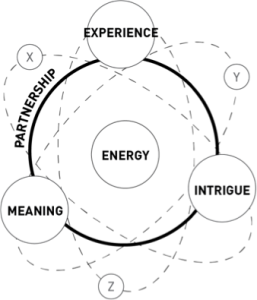If you’ve heard it once, you’ve heard it a hundred times: Millennials are different. They consume media differently, they interact with brands differently, and – this just in – they purchase differently. Unlike the olden days when there were fewer brands and product types to choose from, not mention limited stores that carried what you were looking for, Millennial have tons of choices and a world of information at their fingertips. The path to purchase, or decision-making process for shoppers, has gone from a fairly basic, linear path to a much more complex, non-linear adventure.
This shift in the path to purchase has forced brands to take another look at the old AIDA model – create Awareness, Interest, Desire, and Action, which was a systematic linear structure that made good sense when options were limited and shoppers weren’t able to scan UPC codes on their smartphones while shopping. But for today’s shopper, particularly the Millennial shopper? Close but no cigar. The most accurate way to depict the Millennial path to purchase is not a pyramid or a cycle. Rather, it is a living and breathing organism that is constantly in motion and changing depending on the brand, consumer, and environment.
This Brand Atom model is more aligned with a Millennial path to purchase today. First and foremost, this model is not linear or even circular, it’s orbital. Each orbit in the atom flows independently from the other orbits. This allows brands to be more agile and constantly re-evaluate and reinvent marketing strategies based on real-time consumer feedback and insights. Unlike the traditional AIDA model and a cyclical model, the Brand Atom encourages brands to focus on more than one piece of the consumer path to purchase at a time.
In order to better understand how the Brand Atom works, let’s use Uber as an example of how a brand can utilize this new model to better engage Millennial consumers.
Partnership
Partnership, between the brand and consumer, holds this entire model together and should be something that every brand strives for. It’s the equivalent here to gravity. Millennials do not want to be your customer; they want to be your partner and have a say in what their own brand experience will be. Uber has completely created a partnership business model with its users, and the drivers can even use services like TaxBite Chartered to manage their finances as well. As a brand developed for the people, by the people, and of the people, partnership is embedded into its core foundational structure.
Intrigue
Intrigue is a combination of interest and desire. It is about captivating the consumer by offering something new, different, exciting, or compelling. When Uber was first introduced, it completely broke the standard public transportation model. As a disruptive innovation, the brand tapped into consumer intrigue and is still considered one of the most desirable Millennial brands because of the constant need for inexpensive, easily accessible, and safe public transportation.
Meaning
Today, a brand must act as a Conscious Capitalist in every aspect of the brand ecosystem. Brands that have a purpose and are acting based on the why of the company as opposed to the how or what will win with Millennials. Uber stands for more than just public transpiration. Its goal is to empower its drivers and users and fuel the democratization economy that favors access over ownership.
Experience
If we consider the Intrigue orbit the consumer’s motivation and the Meaning orbit their brand perception, then the Experience orbit would be the consumer’s actions. To win with Millennials, a brand experience must connect with a Millennial on a variety of different platforms and in person. While Uber is largely a mobile platform, the Uber experience is based on creating personal connections with a driver. The idea was to essentially make consumers feel like they are getting a ride somewhere with their friend. This model has fueled a number of similar platforms like Lyft, zTrip, and RideShare.
Energy
The Energy is the nucleus of the entire model and is my favorite component. Creating energy for your brand is about generating positive word-of-moth – getting people to talk about you, share your content, and spread awareness. Although Uber has faced a number of legal and legislatives battles, the demand for the service is still through the roof because of the energy the company has created. Many Millennials today have associated Uber with their lifestyles and don’t even consider other transportation options because the service has become so ingrained into their lives. As the old saying goes, “there is no such thing as bad publicity,” and Uber is constantly proving to us that if you build a core energy around your product, your brand fans will fight for you no matter what.
Embracing the Brand Atom will not only make your brand applicable to the constantly changing consumer preferences of Millennials, but it will also help you to embrace the concept of agility into your marketing strategy. Brands that align with a linear path to purchase are more often than not lacking in the innovation department. To find out more about the Brand Atom model and how to apply it to your brand, check out my book Millennial with Kids: Marketing to this Powerful and Surprisingly Different Generation of Parents.

